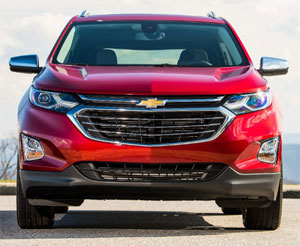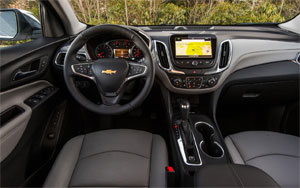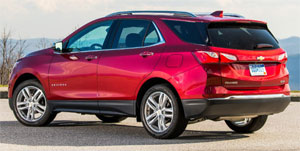2018 Chevrolet Equinox
With crossover utility sales being what they are, you shouldn’t be surprised that the Equinox has long been Chevrolet’s best-selling vehicle that’s not a pickup truck; even though it hasn’t really changed that much since its gen 2 redesign for 2010. Well, an all-new 3rd generation has finally arrived. So let’s find out if it will signal continued four-season success for Chevrolet.
When the Chevrolet Equinox first arrived for 2005, it was GM’s answer to what Honda and Toyota had started in the late 90’s with the CR-V and Rav4; and what has become one of the most popular of all vehicle segments, the compact crossover. And it didn’t take long for the Equinox to get right in the mix for sales, even beating both rivals on occasion.
But that segment is much different now, with more modern rides, and many more of them. So, the all-new 2018 Equinox is well timed.
 Getting on board with the GM weight loss plan means it’s about 400–lbs. lighter than before, and you do feel it.
Getting on board with the GM weight loss plan means it’s about 400–lbs. lighter than before, and you do feel it.
It looks smaller too, and indeed it is, by about 5-inches in length; yet with more efficient packaging, overall passenger volume is actually up, with cargo room about the same.
There’s 29.9 cu-ft. of space behind the rear seats, with a max of 63.5. The seat-folding design is much improved; it’s easier to use and allows for a flatter load floor.
Up front, the driver enjoys a fairly high seating position with good visibility, and pronounced comfort from the back and lower cushions.
Rear seat room is plentiful for a compact ute, and seat comfort is equally good. All techno goodies you might need are available on either a 7 or 8-inch MyLink touchscreen. Available safety includes automatic braking.
But, you’d better like small displacement turbo engines, as that’s all that now powers this Equinox.
This 1.5-liter I4 is standard, with 170-horsepower and 203 lb-ft. of torque; connected to a 6-speed automatic transmission. A 252-horsepower 2.0-liter I4 with a 9-speed automatic is the upgrade, and keeps max towing at 3,500-lbs.
 But, most interesting, is a 137-horsepower 1.6-liter I4 turbo-diesel, arriving shortly after launch; a first for the segment.
But, most interesting, is a 137-horsepower 1.6-liter I4 turbo-diesel, arriving shortly after launch; a first for the segment.
Front drive is standard, with a new selectable all-wheel-drive system available, that fully disconnects the rear axle when appropriate to boost efficiency.
Government Fuel Economy Ratings for the all-wheel-drive 1.5-liter are 24-City, 30-Highway, and 26-Combined. We averaged a very good 28.0 miles-per-gallon of Regular. For an average Energy Impact Score of 12.7-barrels of yearly oil use, and 5.6-tons of CO2 emissions.
Despite the lower weight and smaller engine, the Equinox still drives stable and comfortably, and everything feels a bit more responsive than before.
Even at the higher speeds of our slalom course, it didn’t feel cumbersome at all; displaying only moderate hints of both over and understeer, with minimal computer intervention.
Things weren’t quite as thrilling in the straight line, however. There’s not much in the way of guts off the line, taking us 8.7-seconds to hit 60, or more than a second slower than the CR-V. Engine noise is, however, well-subdued for a 1.5-liter turbo.
 The lack of urgency is consistent throughout the 1/4, accompanied by momentum-killing shifts from the 6-speed auto.
The lack of urgency is consistent throughout the 1/4, accompanied by momentum-killing shifts from the 6-speed auto.
Eventually, the ¼-mile ended in 16.7-seconds at 84 miles-per-hour. Note, an Equinox with the 2.0T and 9-speed more than levels the playing field.
A slight increase in base price over last year puts an Equinox L at $24,525. Top level Premier starts just over 30.
Leaner, but certainly not meaner; the 2018 Chevrolet Equinox has gotten itself into fighting shape, ready to battle it out with all comers in the compact crossover segment. Fully modernized with all-turbo powertrains, more functional interior, and up-to-the-minute tech options; this Equinox does indeed signal more seasons of success for Chevrolet.
Specifications
- Engine: 1.5 liter
- Horsepower: 170
- Torque: 203 lb-ft.
- 0-60 mph: 8.7 seconds
- 1/4 mile: 16.7 seconds @ 84 mph
- EPA: 24 mpg city / 30 mpg highway,
- Energy Impact: 12.7 barrels of oil/yr
- CO2 Emissions: 5.6 tons/yr
2024 Toyota Land Cruiser
Toyota’s Go Anywhere Globetrotter Returns To U.S.
Every once in a while, we all need a reset. A time to get back to basics and prioritize the things that really matter. Well, for the Toyota Land Cruiser that time is now. So, let’s find out if that means bigger and better things for Toyota’s iconic off-roader.
The Toyota Land Cruiser’s status among the global off-road community is legendary, and it’s hard to imagine there’s any corner of the earth where a Land Cruiser hasn’t kicked up a little dust or mud. Well, 2024 sees the return of the Land Cruiser to the U.S. market after a 3-year hiatus, getting a major reset for the journey.
The reset comes mostly by no longer being based on the large three-row “300-series” chassis, but a new version of the smaller “200-series,” now known as the J250. As with the latest Tacoma, it uses the Tundra pickup’s full-size steel frame.
While the main Land Cruiser model, which goes by simply Land Cruiser, is packed full of luxury and convenience features, there is also a stripped-down model known as the 1958, honoring the first year the Land Cruiser made landfall here in North America. And it is that 1958 we have here, and we were glad to see it, as it also celebrates the original’s back-to-basics approach as a blank canvas for you to personalize as you tackle more and more adventures.
Not that it’s fully stripped down, as 8-inch touchscreen infotainment, a 7-inch full-color multi-information display, and automatic climate control are still standard. Plus, some seriously durable materials, and great heated cloth front seats that throw off some get serious 1990s Tacoma vibes.
But outside, there’s a definite lack of flashy trim and basic looking 18-inch wheels with Yokohama Geolander all-season tires; plus, big chunky bumpers and tilt-up back glass, which is a rarity that we appreciate. Though there is a little too much plastic in places that are sure to see some abuse if you do any significant off-roading.
It even feels a little rough around the edges, but for us it just adds to the rugged old-school utility vibe in a good way.
We did just that, both here in the Mid-Atlantic as well as in the California desert; and while there are some tech-forward driving aids, the actual hardware is in most cases plenty to get things done. That includes standard full-time dual-range four-wheel-drive, locking center and rear diffs, and 8.7-inches of ground clearance. A front stabilizer bar disconnect is also available to allow for increased articulation.
Who needs a V6 or even a V8 when you’ve got Toyota’s i-FORCE MAX setup at your disposal with 326 horsepower and 465 lb-ft of torque coming from a 2.4-liter turbo-four with an electric motor sandwiched between the engine and its eight-speed automatic transmission. Low speed torque delivery is impressive. It even feels a little rough around the edges, which may be a turn off to some, but for us it just adds to the rugged old-school utility vibe in a good way.
And it certainly feels quicker than an off roader needs to be, with an instant torque dump as soon as we eased on the throttle at our Mason Dixon test track; helping us get to 60 in 8.1 seconds and through the quarter-mile in 16.3 seconds at 86 mph. Considering the Land Cruiser’s terrain conquering mission, it behaved quite well in our handling course; it was plenty responsive to inputs, with less body roll than we expected and plenty of grip from the tires. The steering was light and quick but as expected didn’t provide much feel. Other than significant nosedive, braking performance was exceptional. Only 107-feet to panic stop us from 60 mph.
With the shift to the smaller size, there’s no more third row available, and cargo capacity now comes in at 46.2 cubic-feet with a max of a still healthy 82.1. Now, the best part of the Land Cruiser’s return is the entry price of $57,445. That’s about 30-grand less than what the last Land Cruiser went for back in 2021.
Whether it’s over the top fashion trends, mullets, or zombies; just when you think they’re dead, they come roaring back to life. Of course, we’re much happier to see the resurrection of this 2024 Toyota Land Cruiser than any of those things. Toyota is one brand that still recognizes the value of full-framed rugged rigs and has also acknowledged that sometimes less really is more. The Godfather of Toyota off-roading is back and better than ever.







